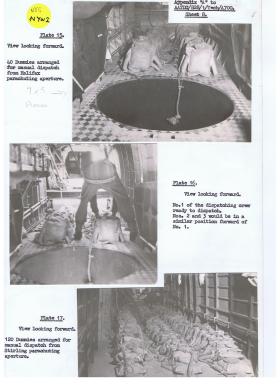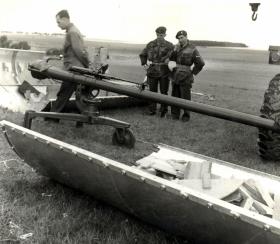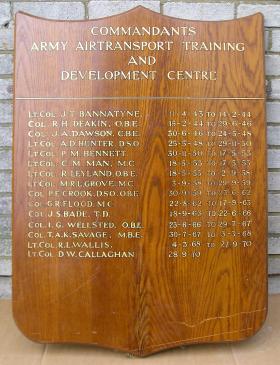
Army Airborne Transport Development Centre
Army Airborne Transport Development Centre
1944 to 1949
The origins of the Army Airborne Transport Development Centre can be traced back to the creation of British Airborne Forces at RAF Ringway in 1940 and the subsequent formation of the Airborne Forces Experimental Establishment (AFEE) in 1942.
The AFEE’s early functions included undertaking loading trials to determine safe and efficient methods of stowing military stores and equipment within different aircraft types. However, capacity issues within AFEE required the formation of a separate unit to undertake the ground work, leaving AFEE free to conduct the air work. As a result, the Airborne Forces Development Centre (AFDC) was formed at Amesbury Abbey in May 1943.
The AFDC’s task was to develop and test equipment peculiar to parachute and glider techniques and to develop tactical glider loads for airborne operations. Loading techniques were investigated for the Horsa, Hamilcar and Hadrian gliders and were later extended to include the Dakota aircraft. A large amount of work was also done on supplies packing and dropping of Army stores.
During the latter half of 1944 the growing need for Air Transport of the Army as a whole (as distinct from Airborne Forces) was appreciated and, in order to embrace and co-ordinate all Army Air Transport requirements, the Centre was reorganised and redesignated as the Army Airborne Transport Development Centre.
In May 1946 the Centre moved to RAF Brize Norton, to enable closer co-operation between the Centre and the RAF Transport Command Development Unit (formerly the Airborne Forces Tactical Development Unit), which provided the air frames for the Centre’s trial drops and exercises and which assisted in the clearance of Army loads for carriage in powered aircraft and gliders. During this period an American Airborne Detachment joined the HQ, not only for liaison purposes, but to take an active part in tests and training.
In June 1949 the Centre was renamed the Army Air Transport Training and Development Centre (AATDC), and together with the Transport Command Development Unit moved to RAF Abingdon.
The centre remained here for two years until March 1951,when the AATDC moved to RAF Old Sarum alongside the Joint Weapons Establishment (JWE).
In January 1968 AATDC became part of the Joint Air Transport Establishment (JATE). JATE comprised three units under the control of Headquarters JATE: the Air Transport Development Unit (which had previously been known as Transport Command Development Unit until 1950); the newly formed Joint Helicopter Development Unit (JHDU); and the AATDC.
A merger of the AATDC and ATDU units occurred around the time of JATE’s relocation to RAF Abingdon, which started in 1970 and completed in 1973. The main part of the JHDU remained at Old Sarum as the Joint Helicopter Tactical Development Unit (JHTDU) and became independent of JATE.
Commandants
| Col RH Deakin OBE | 1944-46* |
| Col JA Dawson CBE | 1946-48 |
| Lt Col AD Hunter DSO | 1948-50** |
*Centre redesignated as the Army Airborne Transport Development Centre (AATDC) during Col Deakin's tenure.
** Centre redesignated as the Army Air Transport Training and Development Centre (AATDC) during Lt Col Hunter's tenure.
Compiled with assistance from Bob Hilton.
Read MoreNewsletter Signup
Donate
Make a donation to Airborne Assault ParaData to help preserve the history of The Parachute Regiment and Airborne Forces
The Airborne Shop
The Airborne Shop is the official shop of Support Our Paras (The Parachute Regiment Charity RCN1131977).
Profits from all sales made through our shop go directly to Support Our Paras, so every purchase you make with us will directly benefit The Parachute Regiment and Airborne Forces.



Latest Comments
There are currently no comments for this content.
Add Comment
In order to add comments you must be registered with ParaData.
If you are currently a ParaData member please login.
If you are not currently a ParaData member but wish to get involved please register.